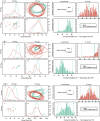The Influence of Habitat Heterogeneity and Human Disturbance on Trophic Interactions of Sebastiscus marmoratus and Scorpaenopsis cirrosa in Wanshan Archipelago
- PMID: 40718689
- PMCID: PMC12289397
- DOI: 10.1002/ece3.71869
The Influence of Habitat Heterogeneity and Human Disturbance on Trophic Interactions of Sebastiscus marmoratus and Scorpaenopsis cirrosa in Wanshan Archipelago
Abstract
Habitat heterogeneity and human disturbances drive variations in interspecific interactions among fish species. Trophic niche analysis is a crucial approach for understanding these interactions. This study investigates the interspecific interaction mechanisms of two scorpionfish species, Sebastiscus marmoratus and Scorpaenopsis cirrosa, across different habitat conditions in the Wanshan Archipelago of the Pearl River Estuary. Three island groups-Guishan Island, Wailingding Island, and Dongao & Wanshan Islands-were selected as study sites. Using carbon and nitrogen stable isotope analysis, we examined variations in their trophic relationships. The results revealed significant regional differences in the δ13C values of S. marmoratus and S. cirrosa (p < 0.05), indicating regional variation in their food sources. Bayesian mixing model analysis showed that at Guishan Island, annelids constituted the primary food source for both species. However, at Wailingding Island and Dongao & Wanshan Islands, their reliance on annelids significantly decreased, with a preference shift towards mollusks, reflecting region-specific foraging strategies and niche differentiation. The δ15N values of the two species did not exhibit significant regional differences, suggesting that S. marmoratus and S. cirrosa occupy similar trophic levels across different regions. Trophic niche metrics, including CR, NR, CD, and TA, indicated that S. cirrosa has a broader trophic niche, suggesting a more flexible feeding strategy and a potential competitive advantage in resource utilization. The two species exhibited overlapping trophic niches, with distinct regional variations. Notably, at Guishan Island, where trophic niches were the broadest, potential competition between the species was most pronounced, which may be associated with higher human activity intensity. Differences in ecosystem structure among islands contributed to variations in food resource availability and niche space, ultimately shaping the foraging behaviors and adaptive strategies of S. marmoratus and S. cirrosa across regions. These findings provide theoretical insights into interspecific interactions in heterogeneous habitats and inform fisheries resource conservation.
Keywords: estuary; geographical variation; interspecific interactions; stable isotopes; trophic niche.
© 2025 The Author(s). Ecology and Evolution published by British Ecological Society and John Wiley & Sons Ltd.
Conflict of interest statement
The authors declare no conflicts of interest.
Figures







Similar articles
-
Spatial, environmental and trophic niche partitioning by seabirds in a climate change hotspot.J Anim Ecol. 2025 Apr;94(4):582-596. doi: 10.1111/1365-2656.14245. Epub 2025 Jan 26. J Anim Ecol. 2025. PMID: 39865930 Free PMC article.
-
Habitat engineering by an apex predator generates spatial trophic dynamics across a temporal environmental stress gradient.J Anim Ecol. 2025 Apr;94(4):611-626. doi: 10.1111/1365-2656.14248. Epub 2025 Jan 29. J Anim Ecol. 2025. PMID: 39887978 Free PMC article.
-
Intraspecific body size determines isotopic trophic structure of a large river fish community.J Anim Ecol. 2025 Jul;94(7):1435-1448. doi: 10.1111/1365-2656.70069. Epub 2025 Jun 9. J Anim Ecol. 2025. PMID: 40485440 Free PMC article.
-
Falls prevention interventions for community-dwelling older adults: systematic review and meta-analysis of benefits, harms, and patient values and preferences.Syst Rev. 2024 Nov 26;13(1):289. doi: 10.1186/s13643-024-02681-3. Syst Rev. 2024. PMID: 39593159 Free PMC article.
-
Systemic pharmacological treatments for chronic plaque psoriasis: a network meta-analysis.Cochrane Database Syst Rev. 2021 Apr 19;4(4):CD011535. doi: 10.1002/14651858.CD011535.pub4. Cochrane Database Syst Rev. 2021. Update in: Cochrane Database Syst Rev. 2022 May 23;5:CD011535. doi: 10.1002/14651858.CD011535.pub5. PMID: 33871055 Free PMC article. Updated.
References
-
- Alves, G. H. Z. , Figueiredo B. R. S., Manetta G. I., and Benedito E.. 2021. “Ontogenetic Diet Shifts: An Additional Mechanism for Successful Invasion of a Piranha Species in a Neotropical Floodplain.” Anais da Academia Brasileira de Ciências 93: e20190868. - PubMed
-
- Bearhop, S. , Adams C. E., Waldron S., Fuller R. A., and Macleod H.. 2004. “Determining Trophic Niche Width: A Novel Approach Using Stable Isotope Analysis.” Journal of Animal Ecology 73: 1007–1012.
-
- Blaber, S. J. M. , Cyrus D. P., Albaret J. J., et al. 2000. “Effects of Fishing on the Structure and Functioning of Estuarine and Nearshore Ecosystems.” ICES Journal of Marine Science 57: 590–602.
-
- Camilleri, A. C. , and Ozersky T.. 2019. “Large Variation in Periphyton δ13C and δ15N Values in the Upper Great Lakes: Correlates and Implications.” Journal of Great Lakes Research 45: 986–990.
Associated data
LinkOut - more resources
Full Text Sources

